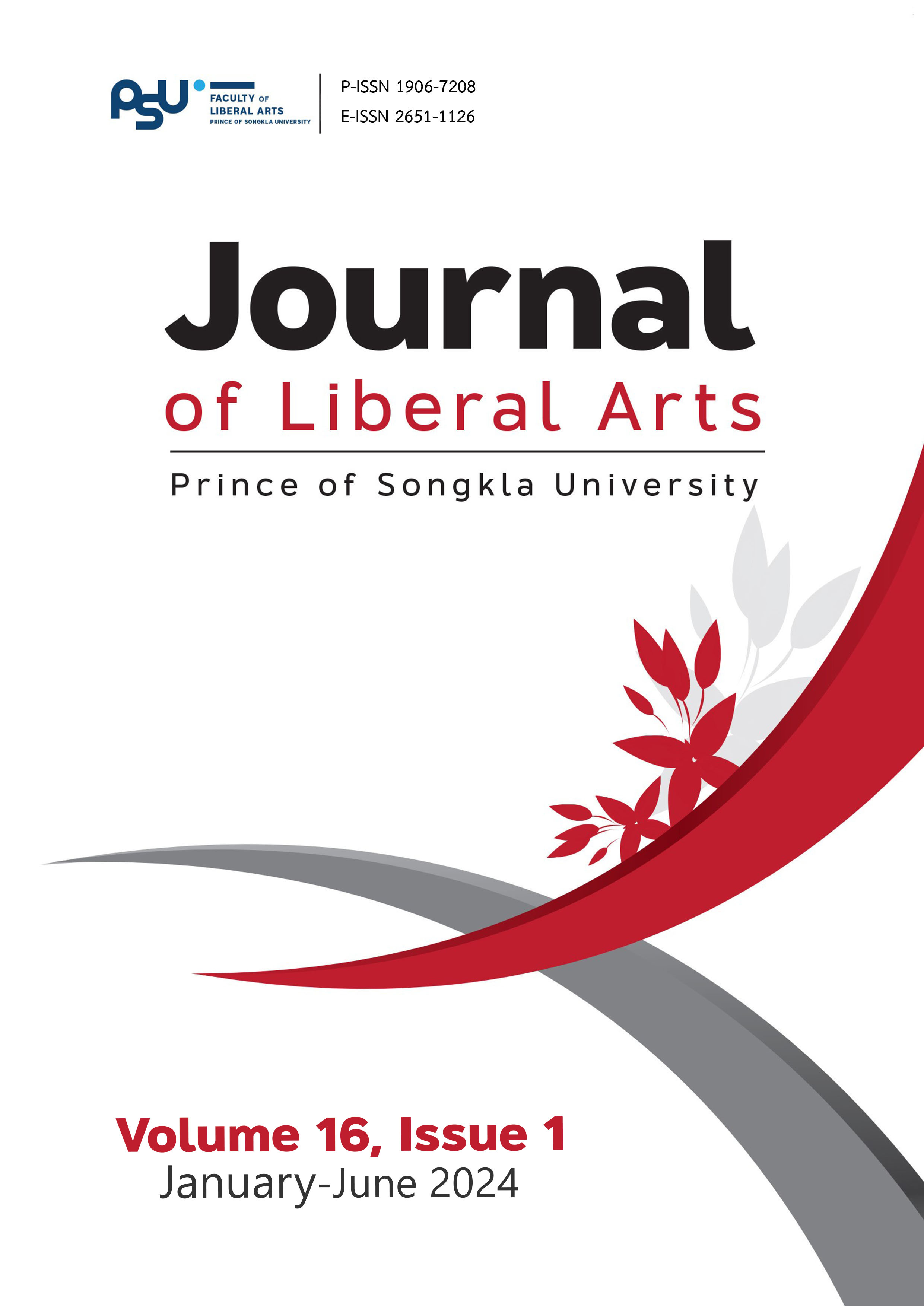Influences of the Séance Ceremony on Politics in Southeast Asia
DOI:
https://doi.org/10.14456/jlapsu.2024.6Keywords:
Séance Ceremony, Schema Theory, PoliticsAbstract
This research aims to discuss how séance ceremonies have influenced politics in Southeast Asia. Four case studies of the séance ceremony from Thailand, Vietnam, Indonesia, and Myanmar were reviewed. Data from documentary studies from various sources, including AnthroSource, ASSIA, Wilson Web, CSA, Sociological Abstracts, and social media during 2000-2023, were examined. Schema Theory was utilized to explore the impact of ghosts on particular political actions. The researchers posited that schemata should be considered a fundamental framework for understanding the cognitive processes and behaviors of individuals. These cognitive structures shape individuals’ interpretations and social interactions within their environment. In the construction of knowledge units, individuals incorporate common elements and characteristics to categorize surrounding objects and phenomena. Three major findings are: 1) the rationality of alternative modernity is considerably integrated within the séance ceremony, thereby increasing the involvement in political activities; 2) rulers adopted the séance ceremony as a strategy for political benefits; and 3) the schema of rulers-ghosts-deities relates to changes in national policy of the four case studies.
References
Aksrondit, T. (2009). Faun Phii: The reflection of negotiation of social power. Tanpun-Ya Limited.
Alexander, P. A., Schallert, D. L., & Hare, V. C. (1991). Coming to terms: How researchers in learning and literacy talk about knowledge. Review of Educational Research, 61(3), 315–343. https://doi.org/10.2307/1170635
Andaya, L. (2000). The Bissu: a study of a third gender in Indonesia. In B. W. Andaya (Ed.), Other pasts: Women, gender, and history in early modern Southeast Asia (27–46). Center for Southeast Asian Studies, University of Hawaii.
Anderson, J. R. (2000). Cognitive psychology and its implications (5th ed.). Worth Publishers.
Anderson, R. C. (1977). The notion of schemata and the educational enterprise: General discussion of the conference. In R. C. Anderson, R. J. Spiro, & W. E. Montague (Eds.), Schooling and the acquisition of knowledge. Erlbaum.
Anderson, R. C. (1978). Schema-directed processes in language comprehension. In A. M. Lesgold, J. W. Pellegrino, S. D. Fokkema, & R. Glaser (Eds.), Cognitive psychology and instruction. Plenum.
Anderson, R. C. (1984). Role of the reader’s schema in comprehension, learning, and memory. In R. C. Anderson, J. Osborn, & R. J. Tierney (Eds.), Learning to read in American schools: Basal readers and content texts. Erlbaum.
Anderson, R. C., & Pearson, P. D. (1984). A schema-theoretic view of basic processes in reading comprehension. In P. D. Pearson (Ed.), Handbook of reading research. Longman.
Arhem, K., & Sprenger, G. (2015). Animism in Southeast Asia. Routledge.
Bartlett, F. C. (1932). Remembering. Cambridge University Press.
Bénédicte, B. P. (2002). Sibling relationships in the Nat stories of the Burmese cult to the “thirty-seven.” Moussons, 5, 31–48. https://doi.org/10.4000/moussons.2670
Bénédicte, B. P., & Jackson, P. A. (Eds.). (2022). Spirit possession in Buddhist Southeast Asia: Worlds ever more enchanted. NIAS Press.
Berger, K. S. (2011). The developing person through the life span (8th ed.). Worth Publishers.
Bern, S. L. (1983). Gender schema theory and its implications for child development: Raising gender-aschematic children in a gender-schematic society. Signs, 8(4), 598–616. https://www.jstor.org/stable/3173685
Boellstorff, T. (2004). The emergence of political homophobia in Indonesia: Masculinity and national belonging. Ethnos 69(4): 465–486. https://doi.org/10.1080/0014184042000302308
Brewer, W. F. (2000a). Bartlett, functionalism, and modern schema theories. The Journal of Mind and Behavior, 21(1/2), 37–44. https://www.jstor.org/stable/43853903
Brewer, W. F. (2000b). Bartlett’s concept of the schema and its impact on theories of knowledge representation in contemporary cognitive psychology. In A. Saito (Ed.), Bartlett, culture, and cognition. Psychology Press.
Bubandt, N. (2009). Interview with an ancestor: Spirits as informants and the politics of possession in North Maluku. Ethnography, 10(3), 291–316. https://doi.org/10.1177/1466138109339044
Buijs, K. (2006). Powers of blessing from the wilderness and from heaven: Structure and transformations in the religion of the Toraja in the Mamasa area of South Sulawesi. KITLV Press.
Chan, M. (2014). Tangki war magic: The virtuality of spirit warfare and the actuality of peace. Social Analysis, 58(1), 25–46. https://doi.org/10.3167/sa.2014.580102
Chauvet, C. (2012). Sous le voile rouge: Rituels de possession et réseaux culturels à Hà Nôi (Viêt Nam) [Under the red veil: Possession rituals and cultural networks in Hanoi]. Les Indes Savantes.
Chonpairot, J. (2016). Pwe dramatic performance in Mandalay. Mekong-Salween Civilization Studies Journal, 7(1), 15–30. https://so04.tci thaijo.org/index.php/jnuks/article/view/56105
Choonara, E., & Robinson, S. (2008). Hunger in a world of plenty. Socialist Workers Party.
Cook, S. & Pincus, J. (2014). Poverty, inequality, and social protection in Southeast Asia: An introduction. Journal of Southeast Asia Economies, 31(1), 1–17.
Davies, S. G. (2002, November). Sex, gender, and priests in South Sulawesi, Indonesia. IAS Newsletter, 27.
Davies, S. G. (2007). Challenging gender norms: Five genders among Bugis in Indonesia. Thomson Wadsworth.
Endres, K. W. (2011). Performing the divine: Mediums, markets, and modernity in urban Vietnam. NIAS Press.
Foxeus, N. (2013). Esoteric Theravada Buddhism in Burma/Myanmar. In T. Ahlbäck & B. Dahla (Eds.), The symposium on digital religion, Åbo/Turku, Finland, 13–15 June 2012 (pp. 55–79). Donner Institute for Research in Religious and Cultural History.
Gleeson, J. (2021). Judith Butler: We need to rethink the category of woman. https://www.theguardian.com/lifeandstyle/2021/sep/07/judith-butler-interview-gender.
Gramsci, A. (1971). Selections from the prison notebooks of Antonio Gramsci. Lawrence and Wishart.
Guthrie, E. (2004). A study of the history and cult of the Buddhist earth deity in mainland Southeast Asia [Doctoral dissertation]. University of Canterbury.
Hayashi, Y. (2003). Practical Buddhism among the Thai-Lao: Religion in the making of a region. Kyoto University Press.
IJsendijk, A. R. (2023). Eight years and counting: Why the gender affirmation law matters in Viet Nam. https://www.undp.org/vietnam/blog/eight-years-and-counting-why-gender-affirmation-law-matters-viet-nam
Jackson, P. A. (2003). Buddhadasa: Theravada Buddhism and modernist reform in Thailand. Silkworm Books.
Jackson, P. A., & Baumann, B. (Eds.). (2021). Deities and divas: Queer ritual specialist in Myanmar, Thailand and beyond. NIAS Press.
Johnson-Laird, P. N. (1983). Mental models. Harvard University Press.
Kamchan, M. (2001). Lao Reūang Phii Lan Na (in Thai) [The story telling of Lan Na ghosts]. Matichon.
Kertzer, D. I. (1988). Ritual, politics, and power. Yale University Press.
Khaing, H. (2016, August 20). Rites and raucous fun at the Taung Byone Nat festival. https://www.frontiermyanmar.net/en/rites-and-raucous-fun-at-the-taung-byone-nat-festival/
Knox, R. (2007, February 5). Vietnam Expands Protection for People with HIV. https://www.npr.org/templates/story/story.php?storyId=7161374
Kozinets, R. (2010). Netnography: Doing ethnographic research online. Sage.
Lewis, I. M. (1989) [1971]. Ecstatic religion: A study of shamanism and spirit possession. Routledge.
Maisuria, A. (2014). The nonlinearization policy agenda and its consequences in England: A focus on resistance now and possibilities for the future. Policy Futures in Education, 12(2), 286–296. https://doi.org/10.2304/pfie.2014.12.2.286
Ministry of Hotels and Tourism. (2021). Festivals of Myanmar. https://tourism.gov.mm/january-festivals/
Morris, R. C. (1994). Three sexes and four sexualities: Redressing the discourses on gender and sexuality in contemporary Thailand. Positions, 2(1), 15–43. https://doi.org/10.1215/10679847-2-1-15
Nguyen, T. B. V. (2012). Exhibit views mother Goddesses’ worship. Vietnamese Women’s Museum.
Nguyen, T. H. (2006). A bit of spirit favor is equal to a load of Mundane Gifts’: Votive paper offering of Len Dong rituals in post-renovation Vietnam. In K. Fjelstad & Nguyen T. H. (Eds.), Possessed by the spirits: mediumship in contemporary Vietnamese communities (pp. 127–142). Cornell University Press.
Ongsakul, S. (2005). Prawattisat Lan Na (in Thai) [History of Lan Na]. Silkworm Books.
Peletz, M. G. (2002). Islamic modern: Religious courts and cultural politics in Malaysia. Princeton University Press.
Peletz, M. G. (2006). Transgenderism and gender pluralism in Southeast Asia since early modern times. Current Anthropology, 47(2), 309–337.
Piaget, J. (1977). The development of thought: Equilibration of cognitive structures. Viking Press.
Ramitanon, C. (2002). Phii Jao Nai (in Thai) [Spirit of ancestor] (2nd ed.). Kledthai.
Rentsch, J. R., Mot, I. & Abbe, A. (2009). Identifying the core content and structure of a schema for cultural understanding, Technical Report 1251. United States Army Research Institute.
Rumelhart, D. E. (1980). Schemata: The building blocks of cognition. In R. J. Spiro, B. C. Bruce, & W. F. Brewer (Eds.), Theoretical issues in reading comprehension. Erlbaum.
Sakamoto, M. (2009). Faun Phii: Northern Thai trance dance photo essay. Center for Southeast Asian Studies, University of Hawaiʻi at Manoa.
Saksung, A. (1996). Satri Nai Sangkhom Chiang Mai Samai Wong Chao Chuea Chet Ton
(in Thai) [Women in the Chiang Mai society in the period of the Chüa Cao Cet Ton Dynasty] [Master’s thesis]. Sinlapakorn University.
Sennett, R. (2012). Together: The rituals, pleasures, and politics of cooperation. Yale University Press.
Spiro, M. E. (1996). Burmese supernaturalism. Routledge.
Strate, S. (2016). The lost territories: Thailand's history of national humiliation. Honolulu: University of Hawaiʻi Press.
Strauss, A. & Cobin, J. (1998). Basics of qualitative research techniques and procedures for development grounded theory. Sage Publications.
Temple, R. C. (1906). The thirty-seven Nats: A phrase of spirit-worship prevailing in Burma by Sir R. C. Temple, with full-page and other illustrations. W. Griggs (Printer of Plates).
Tengakson, P. (2021). Medium. https://thestandard.co/the-medium-5/
Thai PBS. (2023). Mother goddess worship: The physical representation of God. https://www.youtube.com/watch?v=CxYYe3WQqoQ
Thamrin, U. (2015). How economy matters to indigenous identity of Bissu, Transgender priests of South Sulawesi, Indonesia. Asia Research Institute, National University of Singapore.
Vũ, T. T. A. (2015). The modernization of Đạo Mẫu: The impact of political ideology and commercialism on the worship of the mother Goddess in Vietnam. Journal of Indigenous Social Development, 4(1), 1–17. http://hdl.handle.net/10125/38517
Wyatt, D. K., & Wichienkeeo, A. (1998). The Chiang Mai chronicle (2nd ed.). Silkworm Books.
Downloads
Published
How to Cite
Issue
Section
License
Copyright (c) 2024 Patcharin Sirasoonthorn, Wacharawuth Suesat

This work is licensed under a Creative Commons Attribution-NonCommercial-NoDerivatives 4.0 International License.
The authors retain the copyright to their article but the Journal of Liberal Arts, Prince of Songkla University reserves the exclusive rights to first publication.






